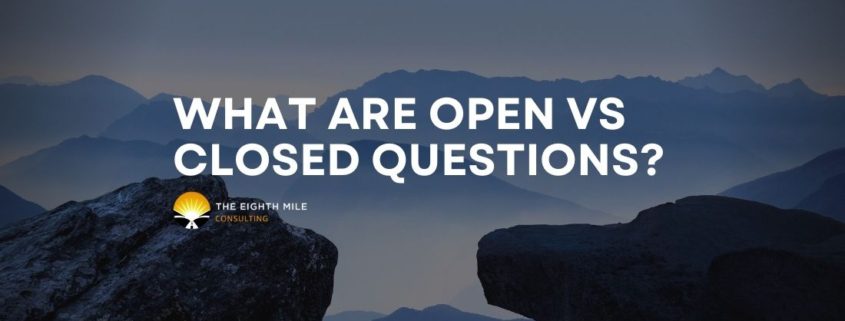What are open vs closed questions and when do we use each question type?
Leadership is an art that requires effective communication and the ability to ask the right questions at the right time. Therefore, even questions play a vital role. Not only to gather information, but also to encourage dialogue, and foster a culture of engagement within a team.
Understanding Open Questions
Open questions are designed to elicit thoughtful and comprehensive responses from individuals. They invite people to share their ideas, opinions, and experiences. Unlike closed questions that can be answered with a simple “yes” or “no,” open questions encourage dialogue, exploration, and deeper understanding. Some examples of open questions include:
- “What are your thoughts on the current project?”
- “How do you envision overcoming the challenges we are facing?”
- “Can you describe a situation where you successfully resolved a conflict?”
Benefits and Uses of Open Questions in Leadership
Open questions offer several advantages in a leadership context.
- Promoting Engagement: Open questions empower team members by giving them a voice and involving them in the decision-making process. This fosters a sense of ownership and commitment within the team.
- Encouraging Critical Thinking: This type of questioning requires individuals to think deeply and express their thoughts in a meaningful way. Cultivating creativity, problem-solving skills, and innovative ideas.
- Building Trust and Rapport: By actively listening to responses, we can demonstrate our genuine interest in team members’ perspectives. This builds trust, enhances relationships, and strengthens the overall team dynamics.
- Uncovering Blind Spots: Open questions also help us uncover blind spots and gain valuable insights into various aspects of a project or situation. They reveal hidden challenges, opportunities, and alternative viewpoints that may have otherwise been overlooked.
Understanding Closed Questions
Closed questions, on the other hand, are specific and can be answered with a brief response. They are particularly useful when seeking factual information or clarifying specific details. Closed questions often begin with words like “Is,” “Are,” “Do,” “Did,” or “Have.” Examples of closed questions include:
- “Did you complete the assigned tasks?”
- “Are you available for the meeting tomorrow?”
- “Have you reviewed the latest report?”
Benefits and Uses of Closed Questions in Leadership
Closed questions serve distinct purposes in a leadership context.
- Gaining Clarity: Closed questions are effective for seeking precise information or verifying understanding. They help us obtain specific details and confirm facts to ensure accuracy.
- Facilitating Decision-Making: This question type can streamline decision-making processes by narrowing down options and prompting individuals to choose from predefined alternatives.
- Time Management: In situations where time is limited, closed questions enable us to quickly gather essential information without lengthy discussions.
The Art of Balancing Open vs Closed Questions
It is essential to strike a balance between open vs closed questions, leveraging the strengths of each. By skillfully combining these two types of questions, we can unlock a lot more potential in our teams.
Foster Engagement and Collaboration: Open questions encourage participation and creative thinking, while closed questions help gather necessary details and move discussions forward efficiently. Both have a time and a place. Sometimes, it’s not ideal to have long, drawn-out conversations. A simple ‘yes’ or ‘no’ will suffice. However, open-ended questions are the key to generating the inclusive group discussions necessary in order to create a high-performing team.
Guide Conversations: We can use a mix of open and closed questions to guide conversations, explore various angles, and ensure that discussions remain focused and productive. Beginning with two closed questions can help us steer the conversation in the right direction, ensuring we maximize productivity during the open discussion that will follow.
Adapt to Different Situations: Understanding when to use open or closed questions allows us to adapt our communication style to different contexts, such as team meetings, one-on-one discussions, or performance evaluations. Closed questions often remove a degree of emotional attachment during difficult conversations. This can be preferable to ensure the discussion remains on topic and factual.
Conclusion – Open vs Closed Questions
The power of questions cannot be overstated in the realm of leadership. Open questions encourage dialogue, critical thinking, and engagement, while closed questions provide clarity, facilitate decision-making, and save time. By utilizing a thoughtful combination of open and closed questions, leaders can effectively navigate conversations, empower their teams, and foster a culture of collaboration and growth.



Leave a Reply
Want to join the discussion?Feel free to contribute!